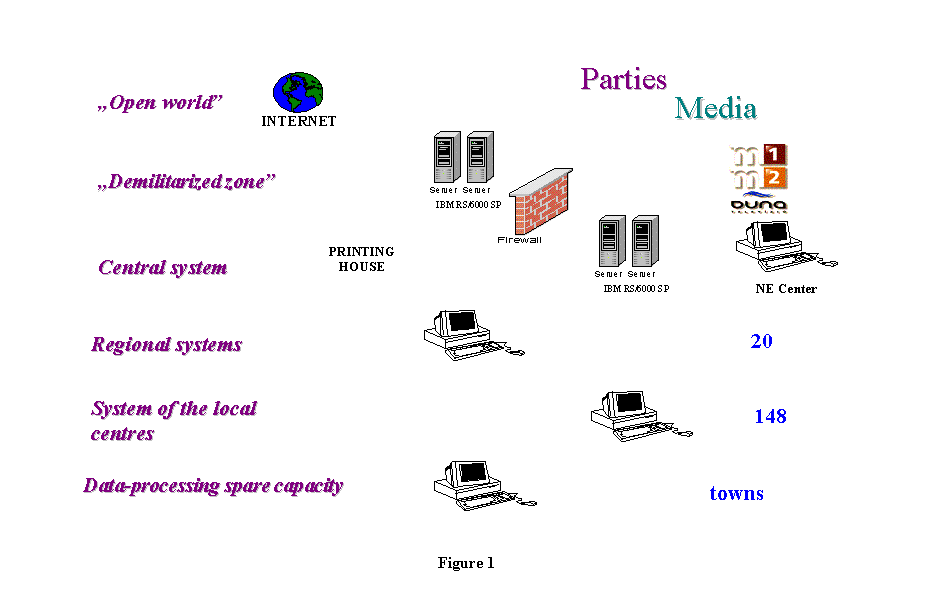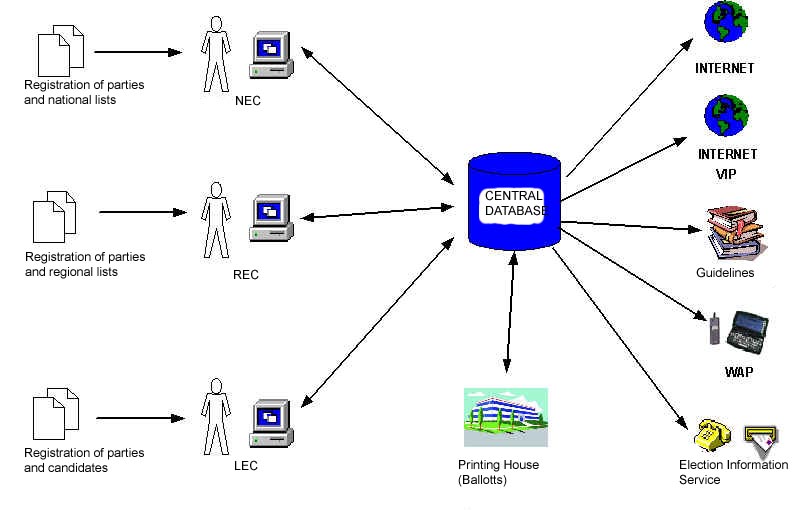

THE DESCRIPTION OF THE COMPUTERISED
DATA-PROCESSING SYSTEM
Computerised data-processing systems
The parliamentary elections of 2002 will be conducted through the regularly operating document-office infrastructure. Document-office systems are typically fully compatible with Internet/intranet
solutions.
The system development solutions applied ensure the operation of electoral systems under reliable conditions, with appropriate protection, in an environment equipped with the required backup
capacities.
The electoral information systems cover the entire electoral process, from the production of the register of voters to the establishment of the final legal
result.
The use of the record system and the integrated application design ensure the achievement of the objectives
set:
- uninterrupted, zero-defect operation,
- supporting the fast and authentic establishing of the election
result,
- maintaining the fairness of the elections, enforcing the basic electoral
principles,
- continuous provision of information to the electoral bodies, the parties, the media and the
public.
The establishment of the preliminary and the final (legal) results continues to be separate, i.e. no data is transferred from the one into the
other.
Figure 1 shows the information model of the elections.
Below, you will find the description of the essential functions of the major information systems supporting the elections. Apart from the systems described, there are numerous smaller systems in operation, ensuring the meeting of information, management and other special requirements, such as, for example, the broadcast-support system of public-service television channels, the election history database, publication production, the financial information system and the internal administration
system.
The system managing electoral districts, the preparation of the register of voters and the registration of the disfranchised people
The system is capable of receiving and transmitting district-based data files through the county database of the updated population-registration system. It manages the file containing the list of the disfranchised, received from the central system, and is capable of the management of the data of voters coming of age by the 2nd round of the parliamentary
elections.
The system is prepared to fulfil the statistical data-provision requirements by the parties, the electoral bodies and by persons authorised to require other types of services.
System monitoring candidate nominations
The system monitoring the proposal of candidates registers the data on the proposal coupons submitted by the candidates, and performs a computer-supported verification. The registration and verification are performed at the single-member constituency (OEVK) centers, using the databases installed at the county administrative offices. The system provides the verification lists and the statistical data required for the decisions of electoral
committees.
The election-preparation system (VER) and the system supporting the transmission and receipt of printing data
The VER is responsible for the registration, at the central database, of the data of individual candidates, parties and lists entering for the elections. It provides up-to-date data for the election bodies, performs data transmission to the Information System, produces statistic reports and provides case-by-case data.
Figure 2 illustrates the candidate nomination process.
It provides data for the National Electoral Committee (OVB) and the Ministry of Finance for the performance of their functions related to the supporting of parties and independent
candidates.
The system is capable of monitoring legal remedies and the completion of deficiencies as well as the supporting of data-verification (the on-line checking of candidate data from the population registration and the register of the disfranchised) during the candidate nomination
period.
Following the closing of candidate nomination, the system performs the forwarding to the printing house, under an accurate, uniform, closed and secure system, of the data required for the production of
ballot-papers.
The system provides the data for the vote summarising database.
The preliminary vote summarising system
This system receives and records the closing data of the register of voters and the non-operating electoral districts. It ensures the receipt of extraordinary events on Election Day and their monitored forwarding to the Information System. It receives, summarises and displays – through the information system – the interim participation
data.
The system performs the preliminary establishment of the result, the registration of data sheets and electoral district official reports, the summarising of votes, the monitoring and displaying of the processing level of the data sheets/reports received. It forwards the continuously received data to the Information System (including the system of public-service television
channels).
The system provides data required for the production of the quick publication in 4+1 languages, supports quick data-provision concerning the preliminary results (and later, at the end of the elections, on the final legal results) to the parties and other pretending organisations (‘Party CD’).
The information systems
Throughout the entire electoral process, the information system ensures – in the form and at the content and frequency corresponding to the characteristics of the various phases and events – the provision of information to the electoral bodies, citizens, the media and the parties, through intranet and/or Internet access and standard file
transfer.
On the days preceding and following the electoral rounds, the system operating at the National Electoral Centre provides the opportunity for inquirers from Hungary or abroad, the representatives of the press and the parties, for personal information; the projected version of the intranet/Internet-based information system enables better
information.
The information system provides connection opportunity to the various content providers (Internet, WAP). The information systems also provide the data displayed in the TELETEXT
system.
The final official result summarising system
The final official result summarising system ensures the receipt and verification of the final result records, and monitors recourse events. It provides data for the establishment of the percentile thresholds of the district lists and performs the preliminary calculations required for the allocation of
seats.
It prepares the National Election Office’s and the National Election Committee’s reports and provides the data of the final official result for the publication-production
systems.
System for reporting the possible electoral fraud
This system has been designed for calling attention to significant differences, using the data from the official reports, through statistical
methods.
Internet information system
The information of the National Electoral Office, to be published on the Internet, contains politically neutral, non-biased information only. The Information system will be available in Hungarian and, with an abridged content, in English.
The remarkable services of the web pages include the publication of dynamic data, providing continuous information, on the election-day, on the number of voters going to the polls. In the evening of the electoral round, informative data are available on the actual state of the counting of votes and the probable allocation of
seats.
Internet service
The Internet service focuses on two major areas:
- the actual electoral events and results and
- general information on the parliamentary elections.
Actual electoral events and results
From the call of the parliamentary elections to the establishment of the final, official result of the elections, the content of the Internet-based information-provision follows the actual
events.
The information begins with the display of the constituency/electoral district structure, to which the information on the registration of parties, individual candidates and lists is added later. On the day of the electoral round, information is provided on the number of people attending and any extraordinary event; later, after the closing of the polling stations at 7:00 p.m., the events of the preliminary summarising of votes can be followed. Following the establishment of the official result of the electoral round/the elections, that result will replace the preliminary data on the web server of the
elections.
General information on the parliamentary elections
Legal
The section contains the public acts, resolutions and decisions providing guidelines for citizens and the electoral bodies concerning the
elections.
National Election Committee (NEC)
The section contains the resolutions of the National Electoral Committee, individual decisions of public interest, the functions of the NEC, the list of its members and the decision of the
Parliament.
Information
The section contains, in a popular format, the general-purpose, informative documents and information concerning the
elections:
- the conceptual system of the various events,
- the presentation of the documents specific to the actual event (ballot-paper, proposal coupon,
etc.),
- the list of the links;
- a multi-lingual (Hungarian, English, German and French) glossary of electoral
terms;
Constituencies
Using maps and text information, it shows the location of single-member and regional constituencies and the respective
settlements.
Election Calendar
The Election Calendar serves the purpose of displaying, with graphic support, the events associated with the various electoral procedures and their
sequence.
The HTML pages contain, by calendar day, the closing dates and operations related to the
elections.
Previous elections
The section contains information concerning former referenda and elections.
Access to the Internet service:
The service can be accessed at the web address www.election.hu, or www.valasztas.hu.
Expert Information Service
This service essentially ensures faster than-average, barrier-free access to the electoral information. Its information content is completely identical with that of the information published on the Internet.
The Expert Information Service (EIS), is provided at request to all the parties putting up a candidate at the parliamentary elections of 2002, the news agencies, the diplomatic bodies accredited in Budapest, the commercial television channels and the national dailies, provided they comply with the following technical
requirements.

